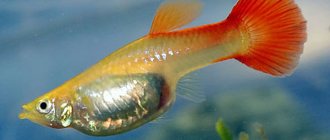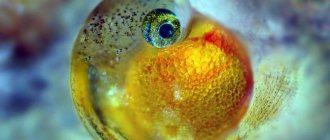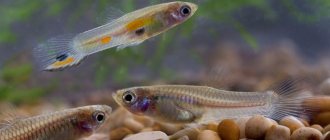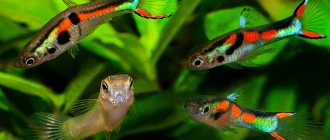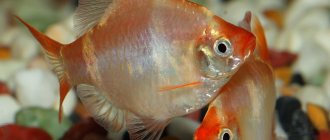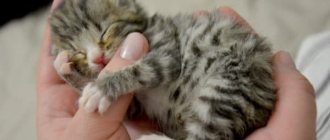Description of the guppy fish
Guppies are freshwater fish, although in their homeland, South America, they also live in slightly brackish waters. Omnivorous.
The size of guppies ranges from 1.5 to 7 centimeters and depends on age, gender and conditions of detention: males, as a rule, are smaller than females, and in too small an aquarium, the fish slow down their growth and may remain dwarfs forever. The wild form of guppy is unattractive, but breeders have developed many brightly colored breeds, often with long fins. It is worth noting that males are much more beautiful than females and therefore, if offspring are not required, it is possible to keep only males.
However, females also have interesting features. Most aquarium fish lay eggs, but guppies are viviparous, that is, small fish are born immediately, not eggs.
Guppy mating process
So how do guppies mate? It is known that when mating, females prefer males with a beautiful and striking caudal fin. Mating begins when the male begins to pursue the female and from time to time leans against her from all sides. To ensure that the female is not exhausted, you need to monitor the number of males that are chasing her. The ideal option is one pair of guppies in a container.
The female is fertilized by the gonopodium - the unpaired copulatory organ of the male, which is formed by modifying the anal fin and consists of a small number of tubes. This reproductive organ is formed only in adult males.
Having mated once, the female will be able to throw fry without a male 10 times in a row with monthly intervals. This is the main feature in guppy breeding.
How to find out if a fish is pregnant
Guppies become sexually mature at 3-4 months: at this age, the fish are already able to reproduce. If females are kept together with males, pregnancy will occur quickly and can be recognized by the appearance of the fish. The abdomen of a pregnant guppy is rounded. This is more noticeable from the front and sides. The longer the period, the more convex the belly becomes and the more prominent the sides are visible when viewed from above. By the way, by this sign you can distinguish a pregnant fish from one that has overfed - in the latter case, the bulge appears only from below. The size of the abdomen also depends on the number of cubs. Therefore, it is difficult to definitively answer the question of how many fry a guppy gives birth to. This indicator varies individually.
Experienced aquarists who know their fish are also able to determine the onset of pregnancy and its duration by the spot near the anus of the female. But this method is unreliable, since in some guppies it appears with the onset of puberty, even before pregnancy, and persists throughout life.
It is surprising that sometimes after one fertilization the female can give birth to fry several times, approximately every month and a half. In this case, the male’s genetic material can last for up to a year.
How to detect pregnancy in a female
Guppies are classified as viviparous individuals because they give birth to fry that are able to survive independently, and do not lay eggs, like other types of fish. Pregnancy of a female is determined by external signs. At the initial stage, its abdomen is rounded, as the guppy bears eggs, then it becomes rectangular, and a black spot appears at the bottom of the abdomen. All these changes indicate that the female will soon give birth.
The gestation period of guppies depends on the number of fry being carried and can range from 20 to 40 days. The smaller the number of fry, the faster the female will give birth and vice versa.
The main point after mating guppies is to keep the pregnant fish in the same conditions. During this period, it is very vulnerable to changes in temperature, light conditions, and water composition. Guppy pregnancy should take place in a comfortable environment and then healthy fry will be born.
How does childbirth go?
Pregnancy usually lasts 21-40 days. You can tell that a guppy is about to give birth by the following signs:
- The guppy's belly, when viewed from the side, looks trapezoidal, and the angle between the head and abdomen is clearly visible.
- The fish always tries to stay close to the heater, if there is one in the aquarium.
- Its activity decreases, and the guppy often freezes in place.
- Appetite worsens or disappears completely.
- Just before giving birth, the fish trembles.
- If the expectant mother is in a common aquarium with males, shortly before giving birth, they may begin to chase her, poking her in the stomach with their nose.
It is important to place the female in a separate container before the fry emerge. Otherwise, other fish, including male guppies, may eat the newborns. What complicates the situation is that fish often give birth at night or early in the morning, and it is easy to miss the right moment. It is best to transplant the female immediately, at the first sign of impending labor.
At the moment of birth of the fry, the fish sometimes freezes. They come out one by one, may already be mobile and try to hide behind plants or decorations, and sometimes, on the contrary, they lie down and gain strength. The duration of labor varies, in some cases reaching four hours or even more - depending on the age and physical condition of the female. How many fry a guppy gives birth to also plays an important role. In any case, after giving birth, it is advisable to give the fish a rest and only after a day transfer it to a common aquarium.
The necessary conditions
Aquarium fish do not require human participation to procreate. This natural course of events is sometimes completely invisible to prying eyes. However, many aquarists are interested in breeding, and for them, breeding guppies at home is an exciting activity. Gupiks are unpretentious, but a favorable result largely depends on care and environmental parameters.
Optimal conditions:
- Maturity of fish. To begin breeding, guppies must grow up and reach four months of age. By this time, the females will be quite ready to bear and give birth to offspring.
- Water quality. Hardness should be no more than 15 units, acidity pH from 6.0 to 8.5, without sharp fluctuations. If the tap water meets these parameters, there is no need to specially prepare it. You can improve the quality of acidic water using coral chips or a special branded product.
- Water temperature. To speed up puberty and stimulate the instinct of procreation in fish, it is necessary to keep them in warm water - at least 25ºC. When the temperature rises to 30ºC, the guppies move closer together more actively.
- Consumption of live food. Bloodworms, tubifex, and insects contain proteins necessary for the sexual activity of fish.
Don’t forget about lighting: the presence of lighting is an additional incentive for reproduction. When exposed to light, the color intensity of males increases, which makes them more attractive to females.
How many fry does a guppy give birth to at a time?
It is known that spawning fish can bring many offspring at once, but what about guppies? In fact, viviparous fish are capable of producing up to two hundred fry at a time. But this is the maximum number, and the minimum can be only ten. The average number is from 30 to 90 fish.
How many fry a guppy can give birth to depends on some factors:
- If a female gives birth for the first time, the offspring are few - up to 20 cubs.
- After the first birth, the number of fry will increase within a year or two, and after that it will decrease again. That is, older fish also do not produce large offspring.
- In case of repeated births after one fertilization in the past, the number of fry will decrease each time.
- Large adults often give birth to about a hundred fry at once.
Avoiding cannibalism
These aquarium fish, unlike others, lack maternal instinct. Guppies are cannibal fish, so after giving birth, the female can safely eat her offspring. To avoid this situation, after birth it is worth separating the fry from the mother, if the spawning took place in a separate vessel. If spawning took place in an aquarium with other fish, you should provide the fry with places where they can hide from large individuals: add various algae, driftwood, and stones to the aquarium.
With good and sufficient nutrition, you can completely wean guppies from cannibalism.
The fish reach sexual maturity at the age of 4-5 months.
Interesting facts about guppies
- Thanks to their unpretentiousness, guppies have acclimatized to Russia: a small population lives in the Moscow River and some other reservoirs of the country. Apparently, aquarists initially released them there.
- Guppies successfully destroy the larvae of malaria mosquitoes. The fish were even resettled throughout most of the warm water bodies of the Earth to help fight the pest.
- The fish were named in honor of the scientist and priest, the Englishman Robert Guppy. In 1886, he was the first to report on viviparous fish. It is noteworthy that he was ridiculed, not believing in the discovery.
- Guppies are the first fish in the world to go into space. On board the Soviet orbital station Salyut 5, they even managed to give birth to offspring. Unfortunately, it is unknown how many fry guppies give birth to in space.
These are such amazing guppy fish.
Why don't guppies reproduce?
Aquarium fish guppies are very prolific, they have babies every 1-2 months. But it happens that offspring do not turn out in any way.
- The simplest thing is that all your fish are same-sex.
- It is possible that the female has become pregnant, but this is not visible from her.
- Your guppies reproduce, but without the supervision of the owner, the fry that are born are quickly eaten.
- There is also a possibility that the aquarium is overcrowded and the fish are under constant stress.
- They may not have enough food, so the body does not have time to prepare for fertilization.
- The water hasn't been changed for a long time. A sharp change in water and a rise in temperature stimulates the fish’s desire to reproduce.
- One of the reasons for guppy infertility is obesity of internal organs associated with excess feeding. Even starvation does not affect the ability to reproduce as much as overfeeding.
Attention! It is important for the owner to be able to distinguish a male from a female, because this is the only way to select a successful pair for reproduction.
Other signs and overfed fish
Groups of males always begin to chase the pregnant female and nuzzle her lower abdomen, so she tries to hide in a secluded dark place.
In the early stages, while there is no abdomen yet, the expectant mother is also distinguished by her behavior: she herself chases the males, moves more and eats abundantly.
Before labor begins, the female develops a swelling in the area of the cloaca. If it appears, remove the fish - labor will begin in 2-3 hours.
If the fish has simply eaten too much, its abdomen also becomes rounded, but if you look at the guppy from above, its sides are not round. The behavior of guppies before giving birth is unusual, but an overfed fish behaves as always.
How to preserve offspring?
The problem of how to care for fry after birth ranks first among beginners' questions. Reproduction of fish will bring pleasure only if you manage to raise the resulting young fish. The most difficult thing is to understand what to feed the fry in the first days. In order for them to grow faster and develop properly, feeding begins from the first day. It is better to take care of food in advance:
- purchase ready-made starter feed in the store;
- breed food organisms yourself;
- Keep the aquarium with the fry in the light so that green algae grows on the walls.
The fry receive everything that is necessary for the growth of young fish with food. Experienced breeders who take care of the selectively bred offspring they need, raise ciliates to feed the fry.
This food is sold under the name live dust. The water containing the microscopic creatures is pipetted into the spawning tank. At first, the fry are able to eat only such small food and algae from the walls of the aquarium. As they grow, the fry's diet includes live crustaceans:
- Artemia nauplii;
- daphnia;
- Cyclops.
In addition to live fish, they are also given concentrated food for fry (colored flakes). Growing fish are fed increasingly larger foods (tubifex, scraped meat, granulated concentrates). The size, richness of color, and good appearance of adults depend on how to feed the fry at an early age.
Care and maintenance of fry
Caring for the fry also includes maintaining a favorable environment in an artificial reservoir. To correct the temperature, a water heater with a thermostat is used. To saturate the water with oxygen, turn on the aerator. The nursery aquarium must have a filter.
In addition to technical devices, the owner must also take care of the quality of water. 1-2 times a week, the bottom is cleaned with a siphon, collecting waste from the juveniles. When cleaning, be careful not to get fish into the siphon. After cleaning, with which 1/3 of the liquid volume is drained from the aquarium, fill it to the previous level with clean, settled water.
Determining the sex of the fry
Another important question is how to determine the sex of born fish, how to understand who is more numerous in the school. Young fish look the same, and become different at the age of 2-3 months. They are already large enough for the owner to see the gonopodium of males. The color and size of the tail of males are also sexual characteristics, but modern breeds, which even beginners prefer to raise, often do not have pronounced differences.
When the sex is determined, it is advisable to separate the young females from the males and raise them separately. If you are not engaged in selective breeding, plant the young animals in a common acarium as a whole flock.
End of labor and possible problems
Maternal instinct in guppies is poorly developed, and the mother can eat her children. If you don't want to put them away, put more rocks and seaweed in the jar so that the babies can hide. A day after the end of the birth, the female is returned to the aquarium.
The fry behave differently: some are immediately active, others lay down on the bottom to rest. This shouldn't scare you. They are healthy, but they need time to get stronger.
There are times when a pregnant female guppy should start giving birth, but does not. There are two options: either you made a mistake in the calculations, or the fish has health problems. There are two methods of inducing labor.
Raise the temperature in the aquarium by 2 degrees (but not sharply, gradually) and replace the water by 30%. Or place a young male with the female. Once labor begins, return it to the aquarium.
Features of the species
Small aquarium fish of the genus Poeciliidae are distinguished by a variety of species. Multi-colored flocks of different colors and shapes of plumage decorate any aquarium.
All species of these viviparous fish reproduce equally, but some are more capricious in terms of care conditions. These are predominantly albinos and individuals of white and pale lemon color, for example, yellow blond.
Guppies with a natural gray color are the most hardy and unpretentious, so for your first breeding experience you should choose not the most exotic elite pets.
It is better for beginners to start breeding guppies with the following species:
- round-finned;
- short-finned;
- large-finned;
- Egler's guppy;
- lyrebirds.
In order for a couple to produce offspring, the male and female must be of the same type. If the first experiment is successful, you can think about selective breeding, since these particular fish are capable of producing pure samples of the breed and are not prone to mutations.
Pregnant female guppies
How does fertilization occur?
The fish must be constantly monitored. If the males chase the female around the aquarium, pinching her from one side or below, this is the first sign that the fish are mating. The main thing is that there are not very many males, provided that guppies breed in a common aquarium. Males are too active, and when there are a lot of them, they are able to drive the female to the point of complete exhaustion, which often leads to her death. The correct ratio of fish: males and females should be equal. The next day after insemination, the male is separated from the female.
The male has a special reproductive organ, the gonopodium, through which fertilization occurs. This organ is tube-shaped and located on the fin of an adult male.
Determination of pregnancy in fish
An inexperienced aquarist may not recognize the expectant mother. We'll tell you how to understand that a female guppy is pregnant.
It is easy to establish this fact: sharp external and behavioral changes are observed. The fish develops a round abdomen, which becomes square before birth. Compared to the background of the abdomen, the female's head looks small. You can tell when labor is approaching by the appearance of a dark spot in the lower abdomen. The shiny black eyes of the fry are visible through the thin skin.
Changes also occur in behavior. Before giving birth, the guppy tends to move less and loses its appetite. Convulsions and vomiting rarely occur. A pregnant fish tries to stay close to the heater.

